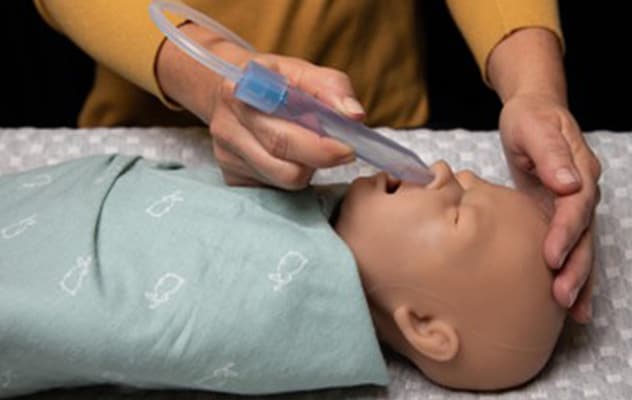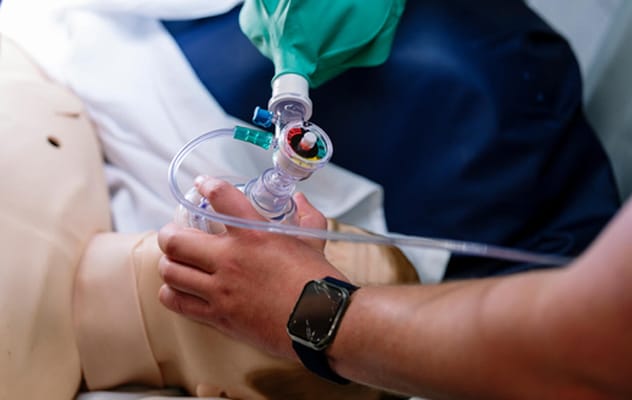Sept. 30, 2025
Airway issues in children are high-risk, low-frequency occurrences, yet awareness of the gravity of these situations is critical, according to Anna M. DePompolo, M.D., a pediatric emergency medicine and critical care specialist at Mayo Clinic in Minnesota. Dr. DePompolo recognizes that due to factors such as work location, title, responsibilities and patient volume, some trauma professionals see a significant volume of pediatric airway issues, while others only see them on occasion. Yet all trauma professionals must be ready to tackle any condition with which a patient presents.
Pediatric Assessment Triangle
 Pediatric Assessment Triangle
Pediatric Assessment Triangle
The Pediatric Assessment Triangle (PAT) is a framework to help approach pediatric care and guide rapid assessment of illness. Image reprinted from Medicine Science. 2021;10:664.
Dr. DePompolo suggests a framework to help approach pediatric care and guide rapid assessment of illness: the Pediatric Assessment Triangle (PAT). This tool, described in a 2010 article published in Pediatric Emergency Care, serves as the center point of the American Academy of Pediatrics' Pediatric Education for Prehospital Professionals course. The academy introduced the tool and the course together in 1998. The PAT provides a rapid read on a child's overall health status by observing:
- Appearance.
- Circulation to skin.
- Work of breathing.
"Ask yourself questions such as, 'Is this a really sick kid who needs intervention?' " says Dr. DePompolo.
She suggests noting the number of affected sides of the PAT. If two sides of the PAT are not functioning well, the child needs intervention, as this indicates a high-risk condition.
"However, if three sides of the triangle are involved, that kid is circling the drain toward extremis and is critically ill," she says.
"Untreated respiratory compromise in pediatric patients is the leading pathway to cardiac arrest, since primary cardiac disease is less common. Infants and smaller children are more likely to have respiratory illness when sick."
Consider the context of a child's airway issue
In children, a respiratory emergency is a frequent cause of pediatric emergency presentation and can lead to grave consequences, notes Dr. DePompolo.
"Untreated respiratory compromise in pediatric patients is the leading pathway to cardiac arrest, since primary cardiac disease is less common," she says. "Infants and smaller children are more likely to have respiratory illness when sick. Viral seasons are tough on kids."
Compared with adults, younger children are more vulnerable to complications from respiratory illness due to their unique anatomical features. Their heads and tongues are large in comparison with the size of other body parts, making the child more prone to obstruction. Additionally, babies under the age of 4 months primarily breathe through the nose, increasing the potential for respiratory distress with congestion.
"In infants, minor respiratory infections can lead to serious complications due to their smaller airways and the fact that they are obligate nose breathers," says Dr. DePompolo. "They are designed to breathe through the nose, which allows them to breathe and feed at the same time. Complications can therefore arise when their upper airways become occluded by mucous from viral upper respiratory illnesses."
Interventions for a small child with airway issues
With small children, Dr. DePompolo recommends starting with the least invasive steps possible to avoid traumatic or uncomfortable treatment, especially if the child is conscious and not in respiratory failure. At the same time, she notes that even some easy-to-perform interventions can make a significant difference for a small child in respiratory distress. She suggests the following steps:
-
Positioning. Oftentimes, a child is not in the ideal physical position to relieve respiratory distress.
"It's easy for children's narrow airways to become obstructed," explains Dr. DePompolo. "Positioning can be a highly effective intervention. In infants and young children, their larger heads and prominent occiput often cause the head to flex forward when lying flat, leading to airway obstruction. Placing a small towel roll under the shoulders helps bring the head into better alignment — the 'sniffing position' — so the child can breathe more effectively."
 Suctioning
Suctioning
A healthcare professional demonstrates the suctioning of mucus from an infant's nose using a manikin.
-
Suctioning and saline. Suctioning alone can make a substantial difference in helping a child improve from a state of respiratory distress, especially infants who are dealing with upper respiratory secretions from a viral illness.
"I'm amazed at the power of suctioning," says Dr. DePompolo. "Even using saline prior to suctioning can help remove the mucous blockage."
-
Supplemental oxygen devices. Use a low-flow or high-flow device for supplemental oxygen depending on the child's condition.
"Supplemental oxygen via a low-flow device, such as a standard nasal cannula, is often sufficient for mild hypoxemia," Dr. DePompolo notes. "When work of breathing is moderate to severe, a pediatric-sized heated, humidified high-flow nasal cannula can help."
As stated in a study published in a 2019 issue of Clinical and Experimental Pediatrics, a humidified high-flow nasal cannula provides high flows that generate a small amount of positive distending pressure and wash out nasopharyngeal dead space, which can reduce the effort to breathe. The heated humidification supports mucociliary function and secretion mobility, making suctioning easier.
-
Apnea and airway protection. Assisted ventilation may be necessary to aid breathing for some children.
"If a child becomes apneic — or shows signs of impending respiratory failure — move immediately to assisted ventilation and prepare for endotracheal intubation or advanced airway placement per pediatric advanced life support guidance," says Dr. DePompolo.
-
Positioning still matters. Keeping the child properly positioned for the best possible breathing is important as you intervene.
"Whatever device you use, keep the airway aligned: maintaining neutral sniffing position," says Dr. DePompolo. "In infants, a small towel roll under the shoulders counters the prominent occiput and helps prevent flexion-related obstruction."
 Bag valve mask
Bag valve mask
Nurses practice using a bag-valve mask on a manikin during a procedural skills training session.
-
Bag valve mask with mechanical ventilation. Using a bag valve mask is an essential skill for pediatric intervention, especially for trauma professionals who are not comfortable with pediatric airway management. Lift the child's chin into the mask rather than pushing the child's head into it. Look for chest rise as you use the bag valve mask to treat the child.
"It's always valuable to practice bag-mask ventilation," notes Dr. DePompolo. "Using a manikin to rehearse bag-valve-mask technique on a pediatric patient helps build skill and confidence for real-life situations."
- Supraglottic airway (SGA) device. An SGA device sized appropriately for a child can be a useful tool for securing the airway in respiratory distress or failure. Compared with endotracheal intubation, SGA devices are less technically complex because they do not require passing a tube through the vocal cords. Practicing insertion on a pediatric manikin helps healthcare professionals become comfortable managing the size of the child's tongue, ensuring proper placement and confirming airway patency with visible chest rise.
Evaluate the patient during treatment
During each airway intervention, reassess how the child is doing, such as whether suction helps. Dr. DePompolo also suggests observing the child with an exposed chest to answer the following questions:
- Is the child breathing and retracting?
- Is the child tugging or head bobbing?
- Is the child limp and not fighting or scared?
"When a child is limp rather than putting up a fight or showing they are frightened, this makes me more concerned," says Dr. DePompolo.
If there is any doubt about the effectiveness of an intervention, a CO₂ detector can confirm airway placement. It is essential to continually reassess whether the intervention is improving the child's status. Use the PAT, capnography and pulse oximetry together to guide evaluation. Visible clinical improvement, such as the child's color progressively improving, is another reassuring sign of effective airway support.
Dr. DePompolo suggests using a high-frequency nasal canula to give the child a push of air if the child's breathing condition requires a step up from other interventions.
Why preparation for pediatric airway management is vital
Dr. DePompolo notes that Level 2, 3 and 4 trauma centers have critical roles to play in saving the life of a child with airway issues.
"Even if you ultimately transfer the patient to a Level 1 Trauma Center, you must intervene at the center where the child presents to prevent cardiac arrest," says Dr. DePompolo. "If 2 to 3 sides of the PAT show poor function, it suggests the child's condition is unstable and requires prompt intervention."
She recommends trying to place airway devices in a low-stress practice environment to build familiarity and proficiency for a much higher stress environment with a child facing airway issues. Dr. DePompolo also encourages trauma professionals to think through what action to take if a strategy fails.
"You need to know what your next step is if a particular technique does not work to help the child breathe correctly," she says.
Becoming a Pediatric Champion
To further your role in helping children with airway issues or other traumatic injuries, Dr. DePompolo recommends applying online to become a Pediatric Champion through Minnesota Emergency Medical Services for Children, where she serves as associate medical director. She suggests that each trauma center identify someone who wants to champion pediatric care for this role.
She notes that individuals who become Pediatric Champions are not necessarily physicians, though they can be. They also may serve in roles such as nurses, paramedics, EMTs, police officers or firefighters.
"This is a go-to person who values care for kids," she says. "It's invaluable to make sure someone at your site is looking out for this."
For more information
Dieckmann RA, et al. The Pediatric Assessment Triangle: A novel approach to pediatric assessment. Pediatric Emergency Care. 2010;26:312.
Kwon J-W. High-flow nasal cannula oxygen therapy in children: A clinical review. Clinical and Experimental Pediatrics. 2019;63:3.
Minnesota Emergency Medical Services for Children Pediatric Champions.